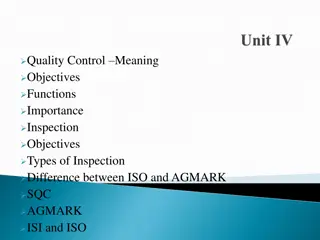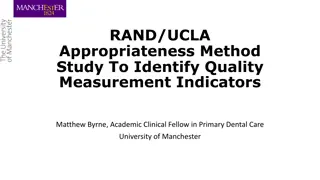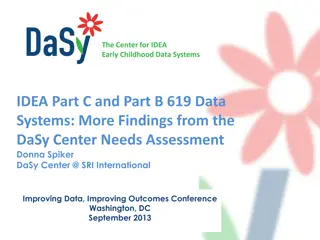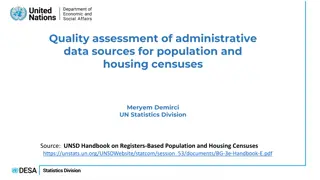
Understanding Bayesian Network Models
Explore the concept of Bayesian network models, which represent joint distributions using structured graphs to depict dependence and independence among random variables. Learn about the components, structure, and various examples of Bayesian networks, including scenarios involving marginal independence, conditional independence, independent causes, explaining away effects, and Markov dependence. Dive into a simple Bayesian network example and understand how to calculate probabilities based on the graph structure.
Download Presentation

Please find below an Image/Link to download the presentation.
The content on the website is provided AS IS for your information and personal use only. It may not be sold, licensed, or shared on other websites without obtaining consent from the author. If you encounter any issues during the download, it is possible that the publisher has removed the file from their server.
You are allowed to download the files provided on this website for personal or commercial use, subject to the condition that they are used lawfully. All files are the property of their respective owners.
The content on the website is provided AS IS for your information and personal use only. It may not be sold, licensed, or shared on other websites without obtaining consent from the author.
E N D
Presentation Transcript
Learning Bayesian Network Models from Data Emad Alsuwat
Bayesian Networks A Bayesian network specifies a joint distribution in a structured form Represent dependence/independence via a directed graph Nodes = random variables Edges = direct dependence Structure of the graph Conditional independence relations In general, p(X1, X2,....XN) = p(Xi | parents(Xi ) ) The graph-structured approximation The full joint distribution Requires that graph is acyclic (no directed cycles) 2 components to a Bayesian network The graph structure (conditional independence assumptions) The numerical probabilities (for each variable given its parents)
Example of a simple Bayesian network B A p(A,B,C) = p(C|A,B)p(A)p(B) C Probability model has simple factored form Directed edges => direct dependence Absence of an edge => conditional independence Also known as belief networks, graphical models, causal networks Other formulations, e.g., undirected graphical models
Examples of 3-way Bayesian Networks Marginal Independence: p(A,B,C) = p(A) p(B) p(C) A B C
Examples of 3-way Bayesian Networks Conditionally independent effects: p(A,B,C) = p(B|A)p(C|A)p(A) B and C are conditionally independent Given A A e.g., A is a disease, and we model B and C as conditionally independent symptoms given A B C
Examples of 3-way Bayesian Networks A B Independent Causes: p(A,B,C) = p(C|A,B)p(A)p(B) C Explaining away effect: Given C, observing A makes B less likely e.g., earthquake/burglary/alarm example A and B are (marginally) independent but become dependent once C is known
Examples of 3-way Bayesian Networks Markov dependence: p(A,B,C) = p(C|B) p(B|A)p(A) A B C
Example Consider the following 5 binary variables: B = a burglary occurs at your house E = an earthquake occurs at your house A = the alarm goes off J = John calls to report the alarm M = Mary calls to report the alarm What is P(B | M, J) ? (for example) We can use the full joint distribution to answer this question Requires 25 = 32 probabilities Can we use prior domain knowledge to come up with a Bayesian network that requires fewer probabilities?
Constructing this Bayesian Network P(J | A) P(M | A) P(A | E, B) P(E) P(B) P(J, M, A, E, B) = There are 3 conditional probability tables (CPDs) to be determined: P(J | A), P(M | A), P(A | E, B) Requiring 2 + 2 + 4 = 8 probabilities And 2 marginal probabilities P(E), P(B) -> 2 more probabilities Where do these probabilities come from? Expert knowledge From data (relative frequency estimates) Or a combination of both
Inference (Reasoning) in Bayesian Networks Consider answering a query in a Bayesian Network Q = set of query variables e = evidence (set of instantiated variable-value pairs) Inference = computation of conditional distribution P(Q | e) Examples P(burglary | alarm) P(earthquake | JCalls, MCalls) P(JCalls, MCalls | burglary, earthquake) Can we use the structure of the Bayesian Network to answer such queries efficiently? Answer = yes Generally speaking, complexity is inversely proportional to sparsity of graph
Learning Bayesian Networks from Data
Why learning? Knowledge acquisition bottleneck Knowledge acquisition is an expensive process Often we don t have an expert Data is cheap Amount of available information growing rapidly Learning allows us to construct models from raw data 14
Learning Bayesian networks B E Data + Prior Information Learner R A C E B P(A | E,B) .9 .1 e b e b .7 .3 .8 .2 e b .99 .01 e b 15
Known Structure, Complete Data E, B, A <Y,N,N> <Y,N,Y> <N,N,Y> <N,Y,Y> . . <N,Y,Y> B E E B P(A | E,B) Learner A .9 .1 e b B E E B P(A | E,B) e b .7 .3 ? ? e b A .8 .2 e b e b ? ? .99 .01 e b ? ? e b ? ? e b Network structure is specified Inducer needs to estimate parameters Data does not contain missing values 16
Unknown Structure, Complete Data E, B, A <Y,N,N> <Y,N,Y> <N,N,Y> <N,Y,Y> . . <N,Y,Y> B E E B P(A | E,B) Learner A .9 .1 e b B E E B P(A | E,B) e b .7 .3 ? ? e b A .8 .2 e b e b ? ? .99 .01 e b ? ? e b ? ? e b Network structure is not specified Inducer needs to select arcs & estimate parameters Data does not contain missing values 17
Known Structure, Incomplete Data E, B, A <Y,N,N> <Y,?,Y> <N,N,Y> <N,Y,?> . . <?,Y,Y> B E E B P(A | E,B) Learner A .9 .1 e b B E E B P(A | E,B) e b .7 .3 ? ? e b A .8 .2 e b e b ? ? .99 .01 e b ? ? e b ? ? e b Network structure is specified Data contains missing values Need to consider assignments to missing values 18
Unknown Structure, Incomplete Data E, B, A <Y,N,N> <Y,?,Y> <N,N,Y> <N,Y,?> . . <?,Y,Y> B E E B P(A | E,B) Learner A .9 .1 e b B E E B P(A | E,B) e b .7 .3 ? ? e b A .8 .2 e b e b ? ? .99 .01 e b ? ? e b ? ? e b Network structure is not specified Data contains missing values Need to consider assignments to missing values 19
What Software do we use for BN structure learning? 20
Idea We use Known Structure, Incomplete Data First, we use Hugin to generate 10,000 cases Then we use this data to learning the original BN model 21
Now we use Learning Wizard in Hugin and try to learn the model 24
Using BN learning algorithms for detecting offense (data corrupting) and defense (data quality) information operations 26
Offensive Information Operation (Corrupting Data) In offensive information operation, the dataset is corrupted and then is used to learn the BN model by using the PC algorithm. What is the minimal data that needs to be modified to change the model? The difficulty on this process can range from easier (such as masking that smoking causes cancer) to hard (such as changing to a desired model). 27
Defensive Information Operation (Data Quality) In defensive information operation, the new data in dataset is introduced and then the PC algorithm uses this dataset to learn the BN model. How much incorrect data can be introduced in the database without changing the model? How can we use Bayesian networks to be able to detect unauthorized data manipulation or incorrect data entries? Can we use Bayesian networks to ensure data quality assessment for integrity aspect? 28
References Bayesian Networks for Padhraic Smyth Learning Bayesian Networks from Data for Nir Friedman (ebrew U.) and Daphne Koller(Stanford)






















